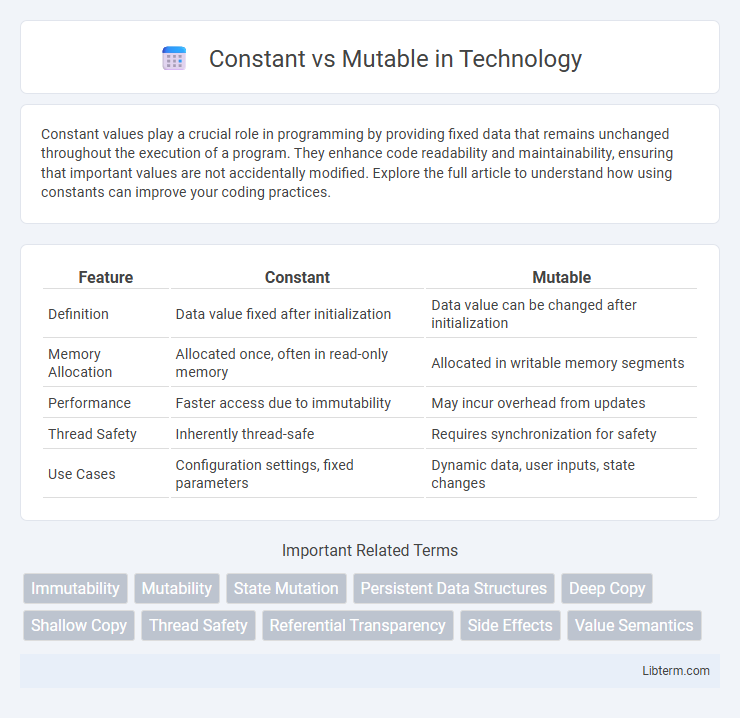Constant values play a crucial role in programming by providing fixed data that remains unchanged throughout the execution of a program. They enhance code readability and maintainability, ensuring that important values are not accidentally modified. Explore the full article to understand how using constants can improve your coding practices.
Table of Comparison
| Feature | Constant | Mutable |
|---|---|---|
| Definition | Data value fixed after initialization | Data value can be changed after initialization |
| Memory Allocation | Allocated once, often in read-only memory | Allocated in writable memory segments |
| Performance | Faster access due to immutability | May incur overhead from updates |
| Thread Safety | Inherently thread-safe | Requires synchronization for safety |
| Use Cases | Configuration settings, fixed parameters | Dynamic data, user inputs, state changes |
Introduction to Constant and Mutable Variables
Constant variables store fixed values that cannot be altered after initialization, ensuring data integrity throughout program execution. Mutable variables allow modifications, enabling dynamic data management and flexibility in coding processes. Understanding the distinction between constant and mutable variables is fundamental for effective memory management and preventing unintended side-effects in software development.
Understanding Constants: Definition and Usage
Constants are fixed values assigned at the time of declaration that cannot be altered during program execution, ensuring data integrity and predictable behavior in code. Commonly used in programming languages like C++, Java, and Python (using conventions or specific keywords like `const`, `final`, or immutable types), constants enhance readability and maintainability by preventing accidental modifications. Their usage is critical in scenarios requiring fixed configuration values, mathematical constants, or any data that must remain unchanged throughout runtime for stable application performance.
Exploring Mutable Variables: Definition and Behavior
Mutable variables are data containers whose values can be changed after initialization, allowing dynamic data manipulation during program execution. They contrast with constant variables, which remain fixed and immutable, ensuring data integrity and preventing accidental modification. Understanding mutable variables is essential for managing state changes and optimizing performance in software development.
Key Differences Between Constants and Mutables
Constants hold fixed values that cannot be changed after initialization, ensuring data integrity and predictability in programs. Mutable objects, such as lists or dictionaries, allow modification of their contents without altering their identity, providing flexibility for dynamic data management. Key differences include memory allocation, where constants often reside in read-only memory, and performance, as mutables may require additional overhead to track changes.
Advantages of Using Constants
Using constants enhances code reliability by preventing accidental value changes, leading to fewer bugs and easier debugging. Constants improve readability and maintainability, signaling to developers which values are meant to remain unchanged throughout the program. Performance optimizations are often possible with constants, as compilers can allocate fixed values more efficiently in memory.
When to Use Mutable Variables
Mutable variables are ideal when dealing with data that requires frequent modifications, such as counters, accumulators, or state tracking in loops and algorithms. Using mutable variables enhances performance by avoiding the overhead of creating new instances for each change, especially in large datasets or complex computations. They are essential in scenarios where in-place updates improve efficiency and clarity, like managing buffers, caches, or iterative refinements in machine learning models.
Common Programming Languages: Syntax Comparisons
In common programming languages, constants are declared using keywords like `const` in C++, JavaScript, and Java, ensuring immutability after initialization, while mutable variables use keywords such as `var` in JavaScript or simple variable declarations in Python, allowing value changes. Python distinguishes constants by convention, naming variables in uppercase letters, whereas C# uses `readonly` for runtime constants and `const` for compile-time constants. Understanding these syntax differences aids in writing predictable and error-resistant code across languages.
Best Practices for Managing State
Immutable state management enhances application reliability by preventing unintended side effects and simplifying debugging processes. Utilizing constants for fixed values preserves code clarity and reduces runtime errors caused by accidental modifications. Employing state management patterns such as Redux or leveraging immutable data structures ensures predictable state transitions and improves maintainability.
Potential Pitfalls and Avoiding Bugs
Constants in programming prevent accidental reassignments, reducing bugs caused by unintended value changes, while mutable variables allow modifications that can lead to unpredictable states if not carefully managed. A common pitfall is mutating objects or collections that were expected to remain unchanged, resulting in hard-to-trace side effects and logic errors. Using immutability patterns, defensive copying, and clear variable declarations helps avoid such bugs by ensuring data integrity and predictable behavior throughout code execution.
Conclusion: Choosing Between Constant and Mutable
Choosing between constant and mutable data types depends on the specific needs of data integrity and flexibility in your application. Constants provide reliable, unchanging values that prevent accidental modification, enhancing code safety and readability in scenarios where data must remain fixed. Mutable objects offer adaptability, allowing dynamic updates and modifications, making them ideal for situations requiring frequent state changes or iterative processing.
Constant Infographic

 libterm.com
libterm.com